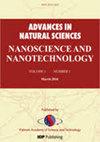Synthesis of V2O5-MgO/TiO2 mixed oxide nanocomposites for photocatalytic treatment of CO in vehicle exhaust emissions
IF 2.1
Q3 MATERIALS SCIENCE, MULTIDISCIPLINARY
Advances in Natural Sciences: Nanoscience and Nanotechnology
Pub Date : 2023-05-11
DOI:10.1088/2043-6262/acd23f
引用次数: 1
Abstract
Photocatalytic nanotechnology is one of the techniques that brings many new breakthroughs since it possesses high potential for the supply of clean energy and the degradation of persistent organic pollutants in the environment. The drawback of photocatalytic materials such as TiO2, ZnO, V2O5 is the activation only under ultraviolet light. To extend the applicability of photocatalytic nanomaterials to a visible light region, recent research has focused on the modification of semiconducting photocatalysts. In this study, V2O5-MgO/TiO2 mixed oxide nanocomposites were synthesised via a sol-gel method by using polyvinyl alcohol as a gelling agent. The basic structural characteristics of nanocomposites were determined by analytical techniques such as scanning electron microscopy (SEM), transmission electron microscopy (TEM), BET, energy dispersive x-ray (EDX), x-ray diffraction (XRD), infrared (IR) and ultraviolet-visible (UV–vis) spectroscopy. The results obtained from EDX and XRD analyses indicate that V2O5 and MgO particles with a size between 14.5 and 21.3 nm were formed and uniformly dispersed in TiO2 phases. Moreover, the effects of oxide weight ratios, illuminating conditions and reaction time on the photocatalytic activity of the nanocomposites were investigated via CO conversion with the input CO concentrations of 8000 ppm. Significantly, the V2O5-MgO/TiO2 nanocomposites were used for treating CO in motorcycle exhaust fumes. The efficiency of the process reached 82% for 10 min, indicating the potential applicability of the V2O5-MgO/TiO2 nanocomposites for the CO treatment of industrial emissions.用于光催化处理汽车尾气中CO的V2O5-MgO/TiO2混合氧化物纳米复合材料的合成
光催化纳米技术是带来许多新突破的技术之一,因为它在清洁能源供应和降解环境中的持久性有机污染物方面具有很高的潜力。光催化材料如TiO2、ZnO、V2O5的缺点是仅在紫外光下活化。为了将光催化纳米材料的适用性扩展到可见光区域,最近的研究集中在半导体光催化剂的改性上。本研究以聚乙烯醇为胶凝剂,采用溶胶凝胶法合成了V2O5-MgO/TiO2混合氧化物纳米复合材料。通过扫描电子显微镜(SEM)、透射电子显微镜(TEM)、BET、能量色散x射线(EDX)、x射线衍射(XRD)、红外光谱(IR)和紫外-可见光谱(UV–vis)等分析技术测定了纳米复合材料的基本结构特征。EDX和XRD分析结果表明,形成了尺寸在14.5和21.3nm之间的V2O5和MgO颗粒,并均匀分散在TiO2相中。此外,在输入CO浓度为8000ppm的情况下,通过CO转化研究了氧化物重量比、光照条件和反应时间对纳米复合材料光催化活性的影响。值得注意的是,V2O5 MgO/TiO2纳米复合材料被用于处理摩托车尾气中的CO。该工艺在10分钟内的效率达到82%,表明V2O5 MgO/TiO2纳米复合材料在工业排放的CO处理中具有潜在的适用性。
本文章由计算机程序翻译,如有差异,请以英文原文为准。
求助全文
约1分钟内获得全文
求助全文
来源期刊

Advances in Natural Sciences: Nanoscience and Nanotechnology
NANOSCIENCE & NANOTECHNOLOGYMATERIALS SCIE-MATERIALS SCIENCE, MULTIDISCIPLINARY
自引率
4.80%
发文量
0
 求助内容:
求助内容: 应助结果提醒方式:
应助结果提醒方式:


